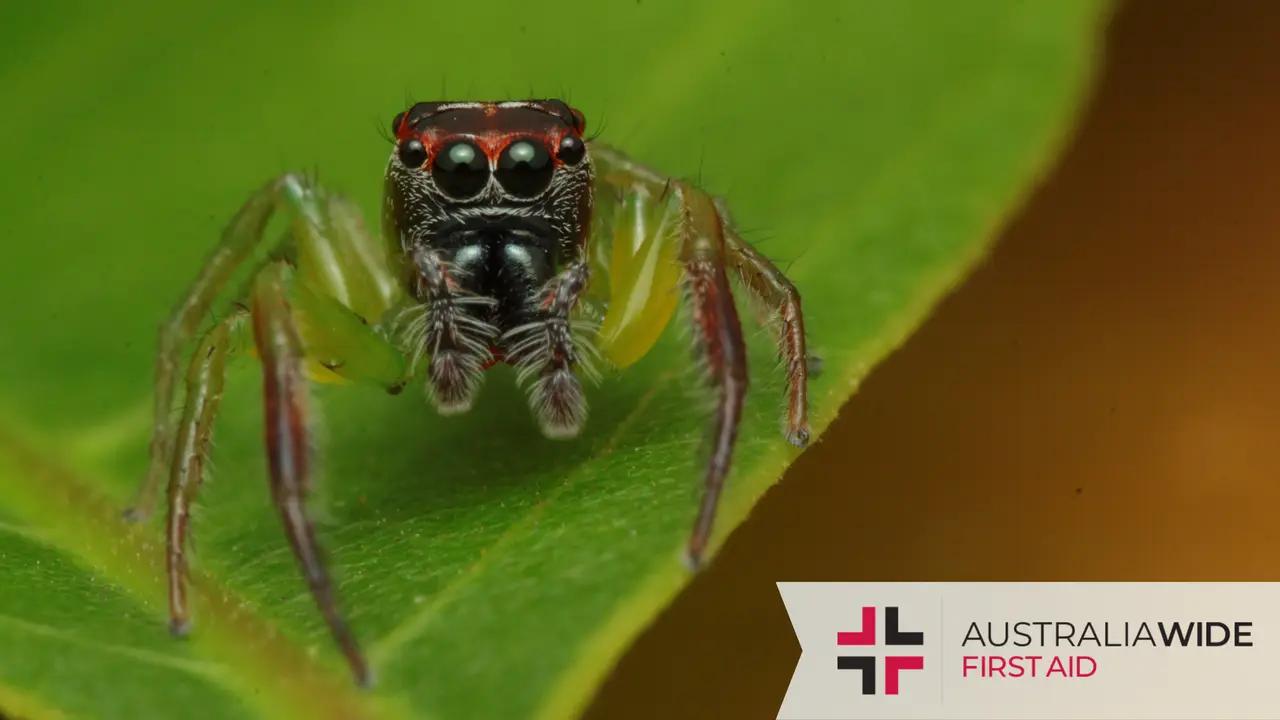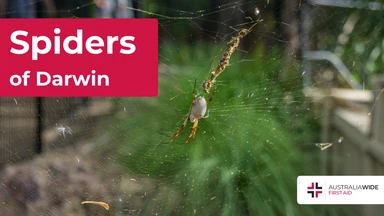The Jumping Green Spider of Australia


The jumping spider family boasts over 5,800 species, making it the most diverse of all spider families, and as their name implies, they are proficient jumpers.
Because they are diurnal predators (they hunt in the daytime), it is not unusual to observe them leaping around your garden or even inside your home.
Today we’re talking about the Green Jumping Spider, also known as Northern Green Jumping Spiders. Its scientific name is Mopsus mormon, though in some older literature it’s referred to as Mopsus penicillatus.
If you’d like some hands-on experience dealing with bites and stings, you can attend one of our general or childcare first aid courses. We have training locations across most places in Australia.
The Green Jumping Spider is the largest jumping spider found in Australia.
The male Green Jumping Spider is bright green in colour, with a dark red head. Their legs are green to dark red, and they have a hairy white crown, with a topknot of black hairs. Their body typically grows to about 15mm in length.
The female Green Jumping Spider is usually about 10mm in length, but can grow up to 18mm. She doesn’t have a white crown or a topknot, and is instead almost entirely green – though she does have a white and brownish-red pattern on her thorax.
The Green Jumping Spider is very common in Queensland, but it can also be found in northern New South Wales, the Northern Territory, northern Tasmania, and Western Australia.
They’re typically found in wet forests and gardens, and are known to venture into urban areas – such as Brisbane – to live in leafy, well-watered gardens.
They live in trees and shrubs, where they’re found hunting.
Green Jumping Spiders hunt actively during the day, typically on foliage where they can camouflage against the green leaves.
They don’t build a capture web, because they are active hunters that jump on their prey, but they do build a silken shelter for resting, moulting, and laying egg sacs.
This spider typically preys on insects and other spiders.
Green Jumping Spider females build their nests and egg sacs on a single curved leaf. Males and females may live in the same nest during mating season.
There is no known danger from a Green Jumping Spider. However, it does have large fangs that can cause a painful bite in humans, as well as numbness and/or swelling.
You can apply a cold compress to the bite site for periods of up to 20 minutes to lessen the pain.
Do NOT use the Pressure Immobilisation Technique, as the venom moves slowly and this will just worsen the pain.
As for all bites and stings, if symptoms persist and/or you’re worried, seek medical attention.
Keep in mind – there have never been any deaths attributed to the Green Jumping Spider, and it’s usually a timid, unaggressive species.
For more information about the most common spider species in Australia and how to treat their bites, please head to our Resource Library.
The Green Jumping Spider (mopsus mormon) is a spider species commonly found along Australia’s east coast.
While it’s one of the largest jumping spider in Australia, it’s neither dangerous nor aggressive. And even though their bite can be painful, it typically isn’t cause for concern.
If you’d like some hands-on experience dealing with bites and stings, you can attend one of our general or childcare first aid courses. We have training locations across most places in Australia.
We run certified First Aid courses throughout all major Australia citys. Find a location near you.

March 11, 2025
Darwin, the tropical capital of Australia’s Northern Territory, is home to a rich diversity of wildlife - including an impressive array of spiders. From the sprawling webs of golden orb-weavers to the cryptic camouflage of trapdoor spiders, these arachnids play a vital role in the local ecosystem. While some may inspire fear, the majority are harmless and even beneficial, helping to control insect populations.

September 4, 2024
Cat bites, while often underestimated, can lead to serious health complications if not treated promptly and properly. Cats' mouths harbour a variety of bacteria that can cause infections in humans.

April 1, 2024
Encounters with wildlife can often be thrilling, but when it comes to the creature known as the drop bear, the experience can quickly turn dangerous. A sharp increase in recent attacks prompts the need for understanding proper first aid procedures in case of an attack.